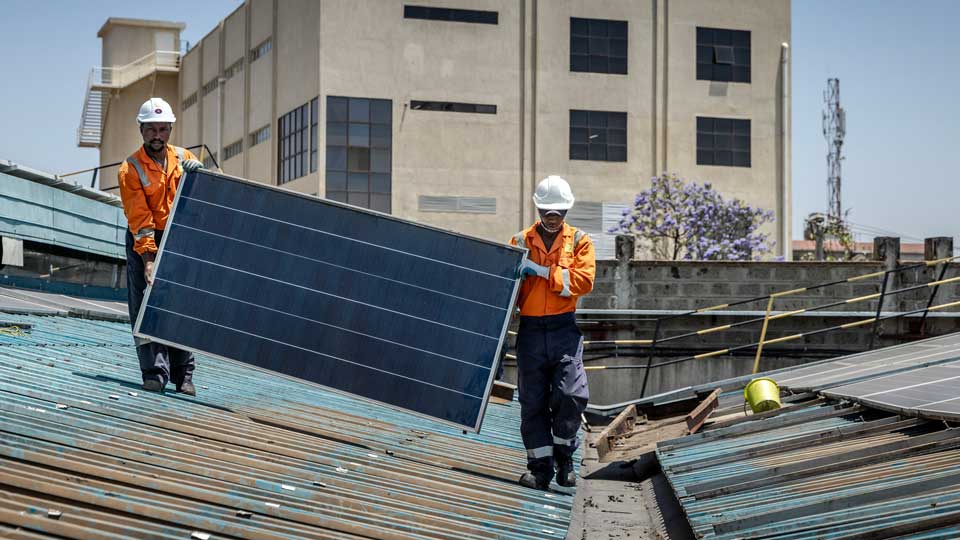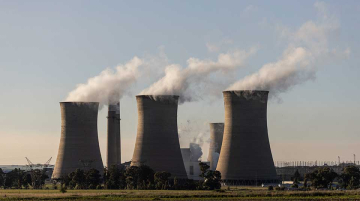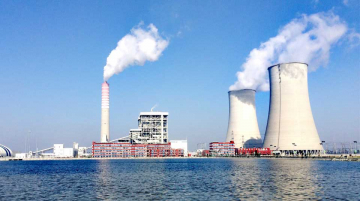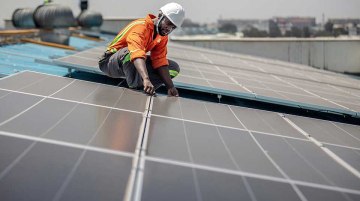
By Tsitsi Musasike, Jiaqi Lu, Adjekai Adjei, and Kevin P. Gallagher
The second decade of China’s Belt and Road Initiative (BRI) promises to be bigger, better, and, importantly, greener.
According to the Chinese Loans to Africa Database managed by the Boston University Global Development Policy Center (GDP Center), China invested $42.6 billion into Africa’s energy sector in the last decade, $1.117 billion of which has been committed to solar and wind power projects (see Table 1 for project details).

With the current energy insecurity on the continent and the pledge by world leaders to increase sub-Saharan Africa’s renewable energy generation capacity from 40 gigawatts (GW) to 300GW by 2030, solar and wind technologies are expected to play a key role in increasing access to clean, affordable and sustainable energy.
The Southern African Development Community (SADC) region’s contribution to this growth is 52.8 GW, which will ensure universal energy access and a 53% renewable contribution to the energy mix by 2040.
China is expected to play a leading role in delivering this green infrastructure. However, scaling up to the envisaged continental target of 300GW by 2030 requires a huge pipeline of well-prepared bankable energy projects.
In addition to the investment in renewables, Chinese companies are increasingly being appointed as the main contractors for new wind and solar energy projects in sub-Saharan Africa. As main contractors, companies are expected to provide performance warranties on these projects. It is, therefore, important for Chinese companies to be involved in project bankability assessments to ensure any associated risks are properly mitigated.
A new report by the GDP Center, the SADC Development Finance Resource Centre, and the SADC Centre for Renewable Energy and Energy Efficiency highlights the need for more project preparation facilities in the early stages of project development.
Of the 41 SADC development finance institutions (DFIs), just seven have an infrastructure mandate and provide project preparation facilities. Only three cross-border regional project preparation facilities serve the 16 SADC member states, namely the Development Bank of Southern Africa’s Project Preparation Facility (DBSA PPF), the DBSA-managed SADC Project Preparation Development Facility, and the Southern African Power Pool (SAPP) Project Advisory Unit’s (PAU) Project Preparation Fund. Only one facility is dedicated to energy sector projects. The region does not have a project preparation facility dedicated to renewable energy and/or energy efficiency.
The report shows that whilst sufficient concessionary funding is available at the investment level, there is a dearth of prefeasibility facilities for renewables. Existing regional and global early-stage or prefeasibility project preparation facilities are inadequate and not easily accessible, especially by local developers. These prefeasibility facilities are important for unlocking the region’s 52.8GW of new renewable generation capacity and more work for Chinese contractors.
Through its Green Investment and Finance Partnership (GIFP), which was unveiled at the BRI Forum in October 2023, China can potentially partner with SADC DFIs to scale up existing project preparation facilities and support early-stage project development. China’s Ministry of Ecology and Environment and the BRI Green Coalition have lined up the BRI flagship financiers of the China Development Bank, Export-Import Bank of China, the People’s Bank of China, China International Capital Corporation and China Power International to participate in the GIFP. The GIFP will ensure Chinese actors’ involvement in the early stages of project development and the bankability of these projects and an even more successful second decade of the BRI.
The joint report also recommends scaling up and restructuring existing facilities to ensure adequacy and accessibility while urging the SADC region to consider exploring new pre-feasibility facilities to generate project pipelines across all member states with new international funding partnerships. Given its growing role in changing Africa’s energy landscape, China is well-positioned to contribute to this global partnership.
Adequate and appropriate support at the early stages of project development is essential to ensuring sub-Saharan Africa stays on course to deliver its 2030 and 2040 climate goals, as well as the region’s broader economic development.
Tsitsi Musasike is a Core Faculty Member of the Global China Initiative at the Boston University Global Development Policy Center and a Professor of Global Development Policy at the Frederick S. Pardee School of Global Studies at Boston University.
Jiaqi Lu is a Senior Academic Researcher with the Global China Initiative and holds a joint Ph.D. in Political Science and Environmental Studies from the University of Wisconsin–Madison.
Adjekai Adjei is a PhD Candidate at the University of Cape Town Graduate School of Business and is a former Global China Pre-doctoral Fellow with the Global China Initiative at the Boston University Global Development Policy Center.
Kevin P. Gallagher is the Director of the Boston University Global Development Policy Center and a Professor of Global Development Policy at the Frederick S. Pardee School of Global Studies at Boston University.








